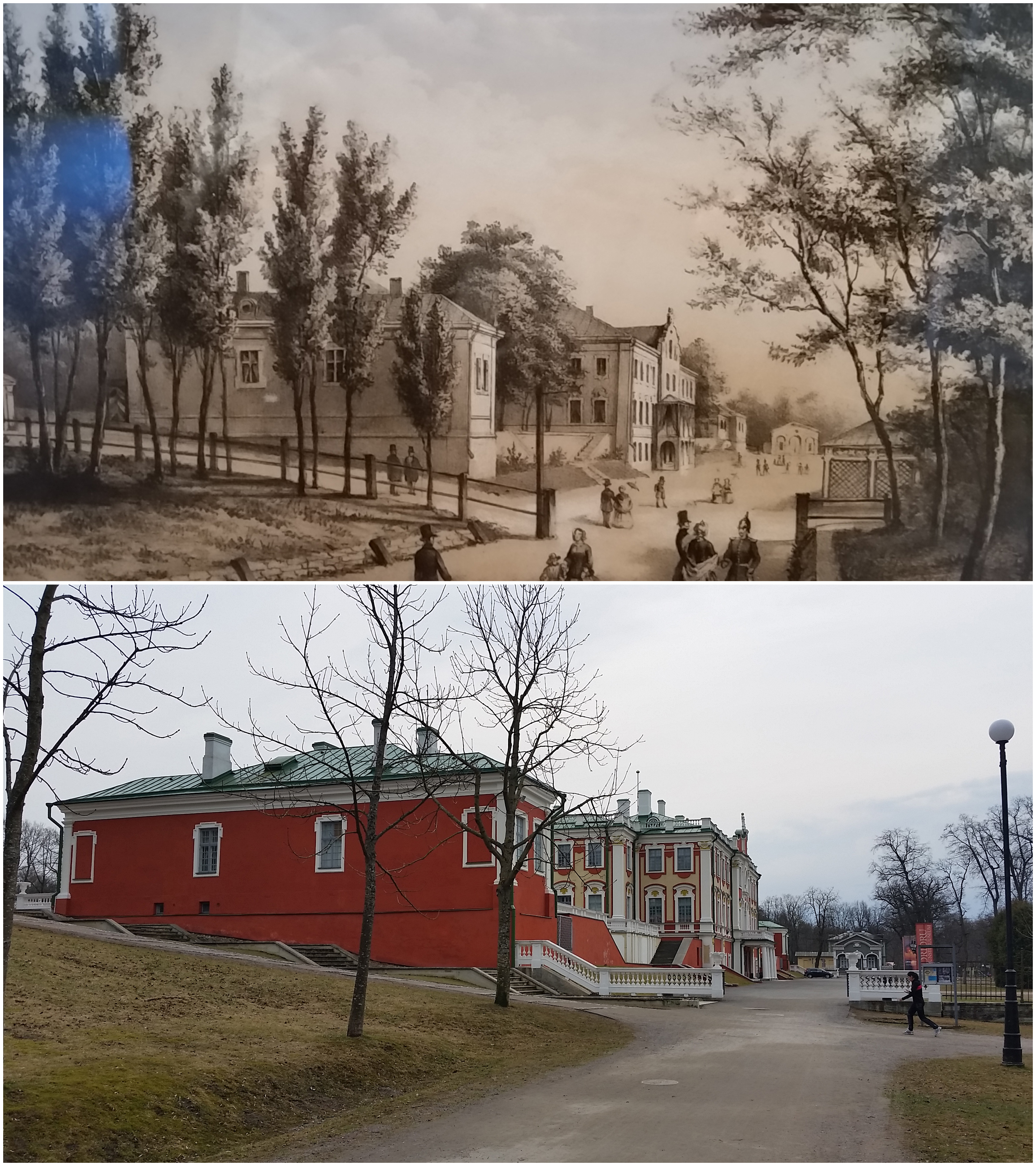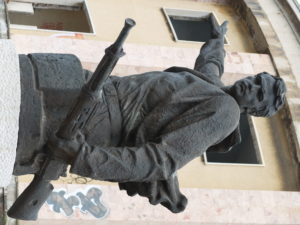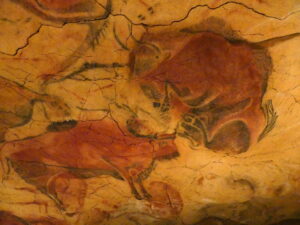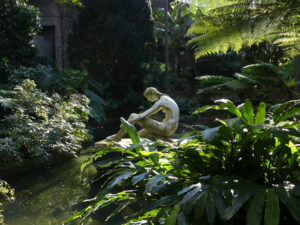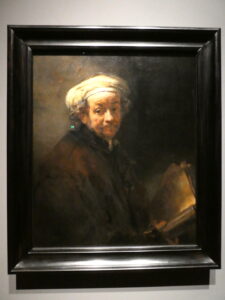
We were well aware of the broad historical sweep here in Estonia: how in the Middle Ages, the Danes along with merchants allied across the Baltic in the Hanseatic League kept control of the country; the conflicts that led to Swedish rule from the mid-16th century to the beginning of the 18th; then the rule by Tsarist Russia beginning with Peter the Great after the horrific Northern, or Nordic, Wars; and finally the start of the Estonian Republic after the end of World War 1 and the overthrow of the Tsars.

Nonetheless we were still surprised to learn that Tsar Peter had built his summer palace on forested land just a short distance east of central Tallinn. In 1718, nearly 300 years ago, once Peter had succeeded in the Northern Wars, he began work on a palace at Kadriorg, “Catherine’s Valley” – or Kadrioru Loss, as the Estonians call it. It was to be the royal summer palace by the sea, a gift for his queen, Catherine I (or Ekaterina in Russian). Putting it here made sense in a way, considering that, fifteen years earlier, Peter had moved the capital of Russia to his new city on the Baltic, St. Petersburg, just a few hundred kilometers away.
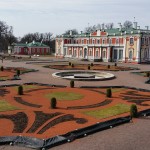
Russian royalty continued to holiday here for the succeeding hundred years and more, including Catherine the Great, their daughter, as well as Alexander and Nicholas I, who substantially renovated it. During that time, Tallinn itself became known as a holiday resort and the palace grounds included a large bathing pavilion by the shore for the royal invitees.
The rest of the land occupied a gently sloping tree-covered hill that is now a public park, a tranquil place right next to the city bustle. Today, coming from the tram at the western edge of the park, you enter by a long roadway that passes by a duck pond and tiny gazebo at your right. In early spring, with the trees just budding, you could see the lovely façade of the palace all along the road and soon approach it head on through an old gate or from the side.
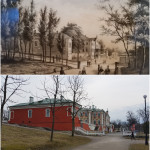
It seems grand and stately, but hardly pretentious, dressed in ochre and cream colors with restrained decoration, most noticeably the arcs above the tall first story windows and a curvaceous pediment atop the center. In the back, the façade is similar except for a second story porch that spans most of the building, a place to look upon the formal gardens patterned after those French kings loved.
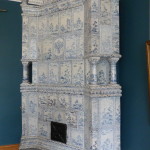
After renovations by the Tsars during the 19th century and by Estonians in the middle of the 20th century (when the Estonian head of state occupied it), little here, including the exterior and even the layout of the rooms, actually looks like it did in Peter’s time. Now it’s a museum of itself, displaying a smattering of old furniture and artefacts such as heating units of Delft china tile that are original.
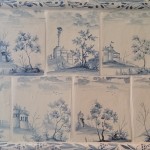
Its rooms also exhibit foreign art works from the holdings of the Estonian Art Museum. The most notable works are from the Netherlands, including a fascinating interactive display about its oldest piece, one of four known versions a la Bosch of Christ’s driving the traders from the temple.
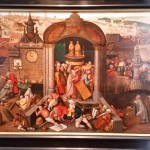
Other rooms display some Italian masters and Russian impressionists, as well as engravings of the palace back when. Nothing like the riches of the Hermitage back in St. Petersburg. Walking these rooms is pleasant enough, but most of them feel less palatial than functional and museum-like.

Only the Great Hall, which some call the Baroque Pearl of the North, has stayed the same except for parquet replacement for its former black and white stone tile flooring. The lower walls start elegantly and modestly enough but become more and more extravagantly baroque as you go up. At floor level, the fireplaces opposite each other are adorned with leafy vines and stucco urns stuffed with stucco laurel leaves. Above the window level begins a stucco fantasia: leafy capitals on the decorative columns, ornate floral decorations around a set of circular reliefs, or tondos, with classical allegories about the royals. Similar detailing surrounds the second story windows at the ends of the room.

On the longer sides of the room at second level, two elaborate pediments form the most extravagant feature of the room high atop the facing fireplaces. In each, two angelic figures with rustling clothes blow gold painted trumpets. They flank a blue painted cartouche featuring a gold letter P on one wall, and E on the other, in honor of Peter and Ekaterina. Crowns shooting out golden rays sit atop the cartouches, while crowned two-headed eagles nest above.
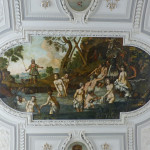
And atop it all, a fanciful curved ceiling with a formal garden’s worth of decoration that frames a huge painting. Based on a Rembrandt work, it largely consists of naked, bathing maidens surprised by a figure with deer horns on his head. The subject is Ovid’s tale of the hunter Actaeon, who comes upon chaste Diana and her nymphs while bathing and is punished by being turned into a stag.
Oddly, it is said to represent Peter’s victory over the Swedish king, with Peter as modest Diana and the Swede as the intrusive horned man. Given the love intrigues often ascribed to Catherine, however, the somewhat prurient painting rather seemed to us to show Catherine as Diana turning her husband into the horned cuckold. But our mind wanders.

Because the room is all very symmetrical and you could even say restrained, you feel as much tranquility as splendor and glory here. Painted allegorical insets affirm that things are indeed good now for the Russian monarchy, with inscriptions declaring that better – presumably more peaceful – times are returning and heralding military arms linked to merit.
The vicious and costly Northern Wars brought much destruction and death; Tallinn itself lost 80% of its population of 10,000. Celebrating the onset of the peace that followed, Peter must have indeed felt that the good times had come, even if – according to some accounts – his wife didn’t like the palace all that much.
(Also, for more pictures from Estonia and the Baltics, CLICK HERE to view the slideshow at the end of the Baltics itinerary page.)


